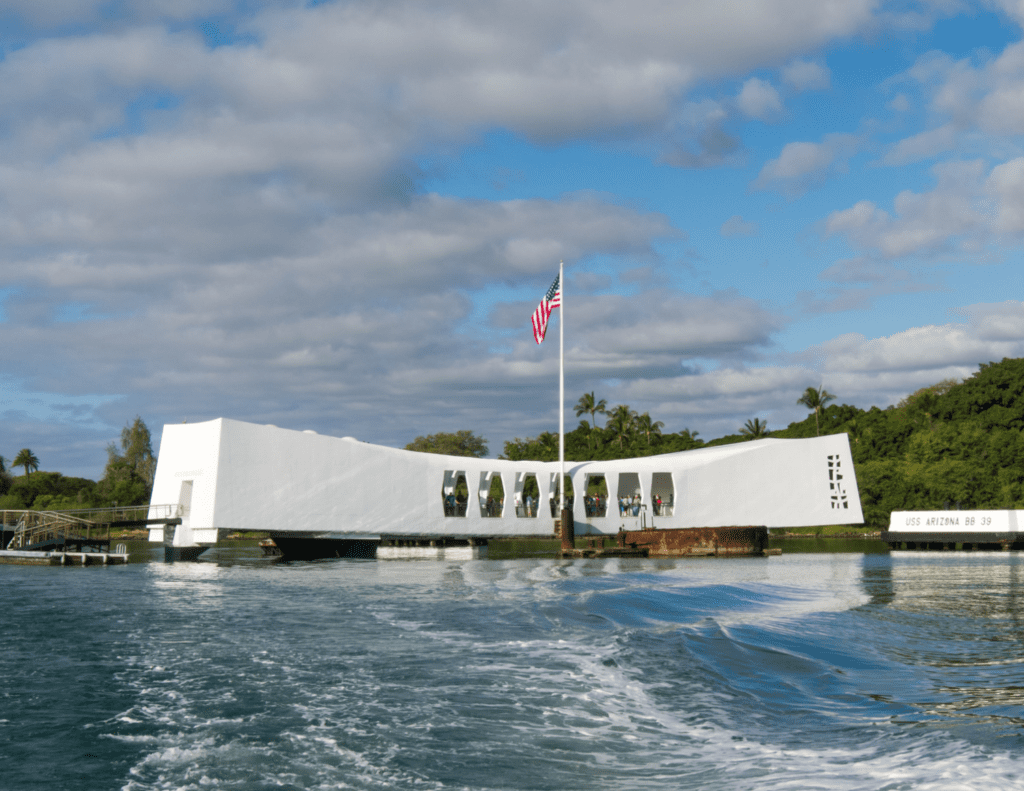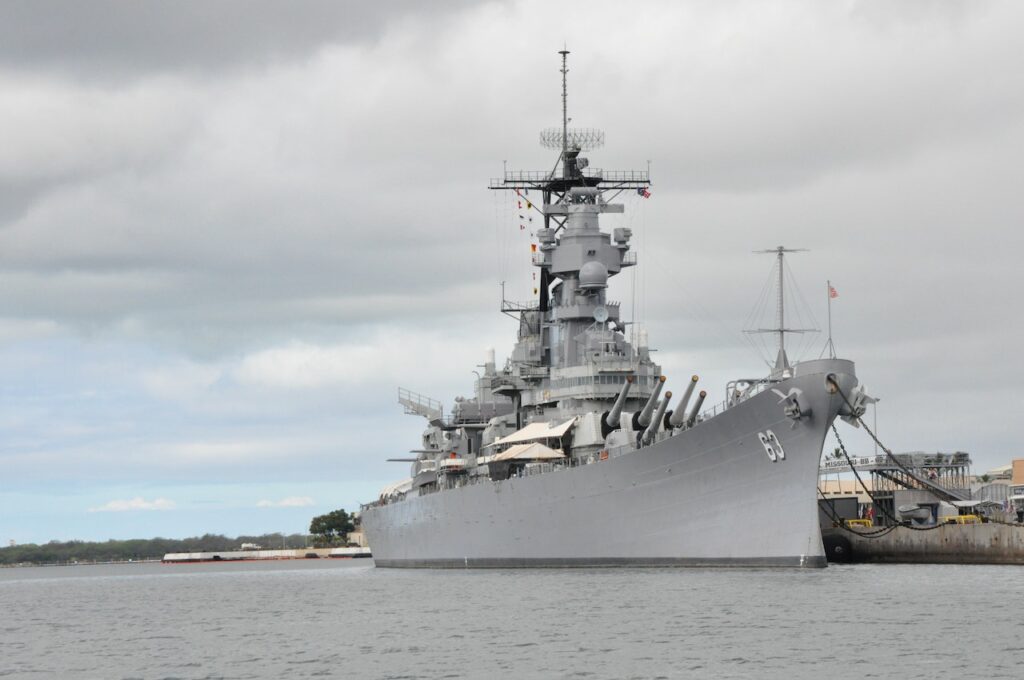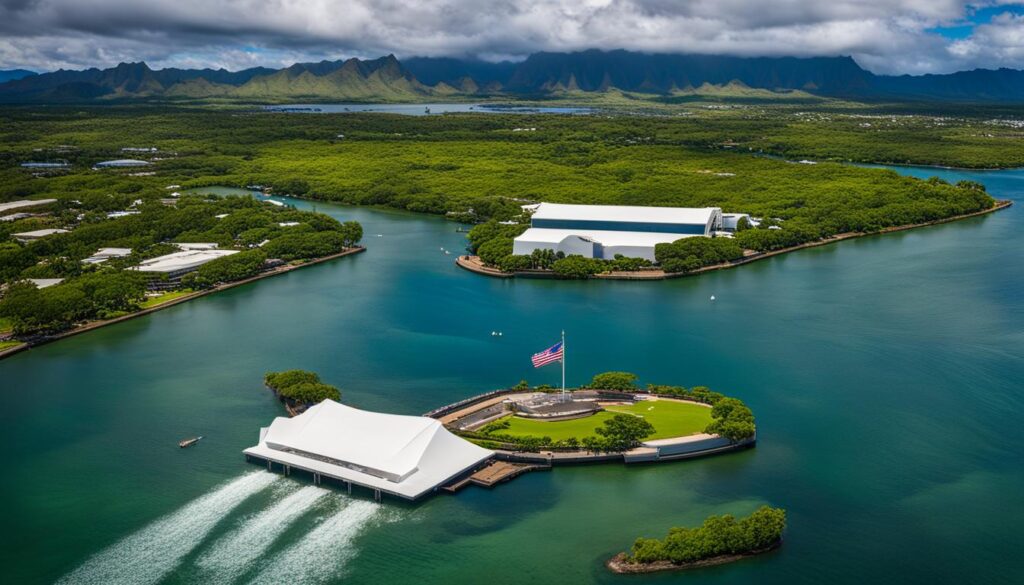Renowned for its pivotal role during World War II, Pearl Harbor on Oahu, Hawaii, is steeped in a rich tapestry of history that predates the infamous attack. Dive into the intriguing evolution of Pearl Harbor, from its days as a royal fishpond to its present-day stature as a national historic landmark.
At A Glance
The Birth of Pearl Harbor: From Fishpond to Harbor
Deriving its name from the once-abundant pearl oysters, Pearl Harbor was initially a flourishing fishing and farming hub for native Hawaiians. The 19th century saw the Hawaiian monarchy transform this area into a royal fishpond, a testament to their affluence and dominance. Constructed with walls that trapped fish while allowing water circulation, this fishpond was a symbol of regal luxury and power.
However, the tides of time brought change. The late 19th century witnessed the overthrow of the Hawaiian monarchy by American magnates and politicians. Following Hawaii’s annexation in 1898, the US discerned Pearl Harbor’s strategic potential and embarked on its military development.

Pearl Harbor’s Naval Evolution
Recognizing its deep-water potential, the US Navy initiated a dredging project in 1908 to accommodate large warships. This transformation spanned several years, culminating in a state-of-the-art naval base equipped with deep-water piers and advanced ship repair facilities. During World War I, Pearl Harbor emerged as a pivotal refueling and supply station for the US Navy in the Pacific, also doubling as a training hub for naval aviation.
As the shadows of World War II loomed, escalating tensions between the US and Japan became palpable. With Japan’s aggressive expansion in Asia, the US fortified its Pacific defenses, including Pearl Harbor, in anticipation of potential conflicts.
December 7, 1941: A Day of Infamy
December 7, 1941, marked a watershed moment in American history. The unanticipated assault by the Japanese military inflicted significant damage on the US Pacific Fleet anchored at Pearl Harbor. This audacious attack, which lasted a mere two hours, resulted in the tragic loss of over 2,400 American lives, with the USS Arizona and its crew bearing the brunt of the devastation.
The repercussions were immediate and profound. The very next day, the US declared war on Japan, marking its official entry into World War II. This event also triggered a surge of anti-Japanese sentiment, culminating in the internment of over 100,000 Japanese Americans during the war.
The attack catalyzed a strategic shift for the US, transitioning from a defensive stance in the Pacific to an offensive one. This change in strategy paved the way for significant battles such as Midway and Guadalcanal, which played crucial roles in tilting the balance of the war in favor of the Allies.
Pearl Harbor: The Post-War Era and Beyond
Post World War II, Pearl Harbor retained its significance as a pivotal US military base. During the Cold War, it was integral to the US strategy in the Pacific. Today, while still an active military base, Pearl Harbor stands as a national historic landmark and a poignant reminder of the sacrifices made during the war.
The USS Arizona, resting at the harbor’s depths, serves as a solemn memorial for those who perished during the attack. The Pearl Harbor Visitor Center offers a deep dive into the harbor’s history, showcasing artifacts, exhibits, and narratives that chronicle the events of that fateful day and its aftermath.
As we stand on the shores of Pearl Harbor, it’s a moment of reflection—a tribute to the indomitable spirit of those who served and a reminder of the values that define our nation. A visit to this historic site is not just a journey through time but a testament to the resilience and unity of a nation.
Embarking on a Pearl Harbor Tour

The Historical Significance of Pearl Harbor
Embark on a Pearl Harbor tour to delve into the historical significance of this iconic location. By visiting Pearl Harbor, you will have the opportunity to discover the events of December 7, 1941, and understand the profound impact they had on World War II. This pivotal moment in history shaped the course of the war and changed the world forever.
What to Expect When You Visit
When you visit Pearl Harbor, be prepared for a powerful and emotional experience. As you explore the various sites and memorials that commemorate the fallen, you will be transported back in time to that fateful day. From the solemn USS Arizona Memorial to the interactive exhibits at the Pearl Harbor Visitor Center, every step of your journey will bring you closer to understanding the sacrifices made by those who served.
Choosing the Right Pearl Harbor Tour for You
When selecting a Pearl Harbor tour, it’s important to consider factors that are most important to you. The duration of the tour, specific attractions included, and any additional activities or amenities offered should all be taken into account. Whether you prefer a guided tour or a self-guided experience, there are options available to suit your preferences and make the most of your visit to Pearl Harbor.
The USS Arizona Memorial: A Tribute to the Fallen
The USS Arizona Memorial stands as a solemn tribute to the fallen sailors and marines who lost their lives during the Pearl Harbor attack. Built over the remains of the sunken USS Arizona battleship, the memorial allows visitors to pay their respects and reflect on the sacrifices made on that fateful day. Through informative exhibits and a peaceful setting, the memorial tells the story of the attack and honors the heroes who defended their country.
Understanding the Events of December 7, 1941
To truly appreciate the significance of Pearl Harbor, it’s important to understand the events that unfolded on December 7, 1941. The attack on Pearl Harbor was a surprise military strike by the Imperial Japanese Navy, targeting the United States naval base in Hawaii. The objective of the attack was to incapacitate the U.S. Pacific Fleet and prevent American interference in Japan’s planned expansion in Southeast Asia.
The Japanese employed a coordinated attack strategy, launching a series of air strikes against American ships and military installations. The assault began early in the morning, catching the U.S. forces off guard. The primary targets were the battleships, aircraft carriers, and airfields located in and around Pearl Harbor.
A timeline of the December 7th assault highlights the sequence of events that unfolded on that fateful day. The Japanese planes attacked in two waves, with the first wave commencing at 7:48 a.m. and the second wave at 8:54 a.m. The devastating attack lasted for approximately two hours, leaving a significant impact on the American naval fleet and infrastructure.
| Time | Event |
|---|---|
| 7:48 a.m. | First wave of Japanese air raid begins |
| 8:54 a.m. | Second wave of Japanese air raid begins |
| 9:45 a.m. | Japanese attack ends |
The impact of the Pearl Harbor attack on World War II was significant. The destruction of the American Pacific Fleet pulled the United States into the war, prompting their formal entry the following day. The attack galvanized American support for the war effort and fueled a sense of national unity. It also propelled the United States to take an active role in the conflict and ultimately shifted the balance of power in favor of the Allied forces.
Vital Logistics: Booking Your Tour and Preparations
Before embarking on a Pearl Harbor tour, it is essential to take into consideration the vital logistics involved in booking your tour and making necessary preparations. This section provides comprehensive guidance on how to book a Pearl Harbor tour to ensure a seamless and unforgettable experience.
Booking a Pearl Harbor Tour
When booking your Pearl Harbor tour, there are several factors to consider. First, determine the mode of transportation that best suits your needs. Options include guided bus tours, private tours, or renting a car to explore the sites independently. Next, check for ticket availability and make reservations in advance to secure your spot, especially during peak tourist seasons. It is also advisable to consider the duration of the tour and the specific attractions that will be included.
Recommended Timeframes for Visiting
Allow ample time to fully experience Pearl Harbor and all its historical significance. A typical tour can last between 4 to 6 hours, depending on the attractions visited and the level of exploration. To make the most of your visit, plan to arrive early in the morning to avoid large crowds and consider spending the entire day immersing yourself in the compelling exhibits and memorials.
Visitor Guidelines and Preparations
Before visiting Pearl Harbor, it is crucial to familiarize yourself with the visitor guidelines set by the National Park Service. This includes ensuring appropriate attire, following security protocols, and respecting the solemnity of the sites. Additionally, it is advisable to bring essentials such as sunscreen, comfortable walking shoes, and a refillable water bottle to stay hydrated throughout the day.
| Logistics | Considerations |
|---|---|
| Transportation | Guided bus tours, private tours, or renting a car |
| Ticket Availability | Check for availability and make reservations in advance |
| Duration | Consider the length of the tour and attractions included |
| Recommended Timeframes | Arrive early and allocate ample time for a complete experience |
| Visitor Guidelines | Familiarize yourself with NPS guidelines and protocols |
| Preparations | Bring essentials and dress appropriately for the tour |
The USS Missouri Battleship: A Symbol of Peace

Exploring the ‘Mighty Mo’
The USS Missouri Battleship, affectionately known as the “Mighty Mo,” holds a significant place in history as a symbol of peace. During your Pearl Harbor tour, make sure to explore this iconic battleship and gain insight into its storied past.
The USS Missouri played a crucial role in World War II, serving as the site where Japan officially surrendered, marking the end of the war. This battleship is a testament to the resilience and determination of the Allied forces, and visiting it offers a unique opportunity to understand the magnitude of their achievements.
Step on board the “Mighty Mo” and discover the various decks and compartments that tell the stories of the brave individuals who served on this powerful vessel.
The Site of the Surrender: A Walk Through History
A visit to the USS Missouri Battleship allows you to experience the historic site where General Douglas MacArthur accepted Japan’s surrender on September 2, 1945. This momentous event marked the official end of World War II and solidified the USS Missouri’s place in history.
As you walk through the halls and chambers of the battleship, you can imagine the emotions and significance of that fateful day. The memory of the surrender lives on within the walls of the USS Missouri, providing visitors with a profound connection to the past.
Take a moment to reflect on the sacrifices made by those who fought for freedom and the enduring legacy of peace that the USS Missouri represents.
Pearl Harbor Tour
A Pearl Harbor tour offers visitors the opportunity to immerse themselves in the history and significance of this iconic location. Guided tours provide informative commentary and ensure you don’t miss any important details. From the USS Arizona Memorial to the Pearl Harbor Visitor Center, there are a variety of historical sites to explore and learn from. Engage in interactive exhibits, watch historical films, and take part in activities that bring the past to life.
The USS Bowfin Submarine: Delving Deeper into Naval History
The ‘Pearl Harbor Avenger’
The USS Bowfin Submarine, known as the “Pearl Harbor Avenger,” played a significant role in World War II and holds a special place in naval history. After the devastating Pearl Harbor attack, the USS Bowfin was among the submarines deployed to retaliate. This section explores the bravery and tenacity of the submariners who served aboard the USS Bowfin and their crucial contributions to the war effort.
Inside a WWII-Era Submarine
Visitors to the USS Bowfin Submarine have the opportunity to step back in time and experience the conditions of a WWII-era submarine. Exploring the cramped quarters and intricate machinery, you can gain a firsthand understanding of the challenges and hardships faced by submariners during wartime. The immersive experience provides a glimpse into the daily lives of those who bravely navigated the treacherous waters of the Pacific Ocean.
Engaging Activities at the Pearl Harbor Visitor Center
The Pearl Harbor Visitor Center offers a range of engaging activities that provide a deeper understanding of the events that unfolded on December 7, 1941. Visitors can explore historical exhibits, watch educational films, and view memorabilia and artifacts of valor, all of which contribute to a comprehensive and immersive experience.
Historical Exhibits and Educational Films
The Pearl Harbor Visitor Center is home to a variety of historical exhibits that showcase the significance of Pearl Harbor in World War II. These exhibits provide valuable insights into the attack, its impact on the war, and the heroic actions of those involved.
Visitors can also watch educational films that further enhance their understanding of the events and provide a visual perspective on the history of Pearl Harbor. These films offer a unique opportunity to hear personal accounts and gain a deeper appreciation for the sacrifices made.
Memorabilia and Artifacts of Valor
At the Pearl Harbor Visitor Center, visitors can view a collection of memorabilia and artifacts of valor, which offer a tangible connection to the past. These artifacts, including uniforms, equipment, and personal belongings, provide a glimpse into the lives of those affected by the attack and serve as a testament to their courage and sacrifice.
By showcasing these items, the Pearl Harbor Visitor Center creates a powerful and meaningful experience, allowing visitors to reflect on the events of December 7, 1941, and honor the bravery of those who served.
Air, Land, and Sea: Comprehensive Tours of Historic Significance
For those seeking a comprehensive experience, there are Comprehensive Pearl Harbor tours that encompass air, land, and sea, allowing visitors to explore the history and significance of Pearl Harbor from various perspectives. These tours offer a unique opportunity to immerse oneself in the historic significance of Pearl Harbor and gain a comprehensive understanding of its impact on World War II.
Whether you choose a helicopter tour, a guided land tour, or a boat tour, each option provides a distinct vantage point to appreciate the historical significance of Pearl Harbor. A helicopter tour offers a bird’s eye view of the area, allowing you to witness the scale and strategic location of the naval base. A guided land tour takes you to the key historical sites, providing a detailed exploration of the events that unfolded on December 7, 1941. A boat tour allows you to experience the harbor itself, sailing through the waters that once witnessed the devastating attack.
By combining air, land, and sea elements, these comprehensive tours offer a multi-dimensional experience that brings the history of Pearl Harbor to life. Immerse yourself in the stories and memories of the past as you visit the USS Arizona Memorial, the USS Missouri Battleship, and other significant sites. Gain a deeper understanding of the sacrifices and heroism displayed by both the servicemen and civilians during this pivotal moment in history.
Whether you are a history enthusiast, a veteran, or simply someone who wants to pay tribute to the fallen, these comprehensive tours provide a unique opportunity to connect with the historic significance of Pearl Harbor. By exploring the site from different perspectives, you can gain a more profound appreciation for the impact it had on World War II and the subsequent course of history.
| Tour Type | Description |
|---|---|
| Helicopter Tour | Experience breathtaking aerial views of Pearl Harbor and the surrounding area. |
| Guided Land Tour | Explore key historical sites and gain in-depth knowledge from knowledgeable tour guides. |
| Boat Tour | Sail through the harbor and witness the strategic location of the naval base firsthand. |
Remembrance and Reflection: The Significance of Your Visit
A visit to Pearl Harbor is an opportunity for remembrance and reflection, allowing us to honor the heroes and survivors of the historic Pearl Harbor attack. By exploring the sites and memorials that commemorate this pivotal moment in history, we can gain a deeper understanding of its significance and impact.
Paying Homage to Heroes and Survivors
During your visit to Pearl Harbor, it is important to pay homage to the brave men and women who lost their lives on December 7, 1941, as well as the survivors who endured the devastating attack. By showing our respect and appreciation, we honor their sacrifices and ensure that their stories are never forgotten.
Cultural Impact and Continuing Legacy
The cultural impact of Pearl Harbor extends beyond the events of that fateful day. It has shaped the course of history and influenced our understanding of war, peace, and the resilience of the human spirit. By visiting Pearl Harbor, we become part of a shared legacy, carrying forward the lessons learned and promoting a future of peace and understanding.
As we reflect on the significance of our visit, we are reminded of the importance of preserving and sharing the history of Pearl Harbor. Through continued education, memorialization, and remembrance, we ensure that future generations understand the enduring impact of this historic site and the brave individuals who were forever changed by the events of December 7, 1941.
